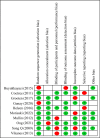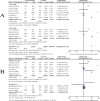Adverse Neonatal Outcomes in Pregnant Women with Severe Vomiting: A Meta-Analysis
- PMID: 40765780
- PMCID: PMC12319452
- DOI: 10.18502/ijph.v54i5.18626
Adverse Neonatal Outcomes in Pregnant Women with Severe Vomiting: A Meta-Analysis
Abstract
Background: We aimed to systematically evaluate the risk of negative effect for newborns born to expectant mothers with severe vomiting in terms of birth weight, premature delivery, low Apgar score, and NICU hospitalization.
Methods: We conducted a systematically search for relevant studies on PubMed, Embase, Cochrane Library, and CNKI databases, using Newcastle-Ottawa Scale to evaluate research quality, and RevMan 5.3 software for meta-analysis from 2009 to 2022. The main outcome measures were: Low-birth weight, preterm delivery, low Apgar score and growth restriction.
Results: In 9 studies, the risk of Low birth weight in hyperemesis pregnant women was increased, and the random effect model was OR 2.38 (95% CI 0.43 to 13.13). The heterogeneity of the study was high (I2=100%). Four studies showed an increased risk of low Apgar scores, with an OR of 2.69 (95% CI 0.30 to 24.48), and high heterogeneity (I2=95%). The risk of premature birth in 5 papers is equivalent, with an OR of 0.93 (95% CI 0.71 to 1.22) and low heterogeneity (I2=6%). The risk of growth restriction was higher in 7 papers, with an OR of 1.31 (95% CI 0.93 to 1.85) and lower heterogeneity (I2=29%). Subgroup analysis showed that heterogeneity mainly stemmed from differences in the definition of hyperemesis.
Conclusion: Pregnant women with severe vomiting have a higher risk of giving birth to babies with low birth weight and low Apgar scores, and a higher risk of giving birth to babies with growth restriction, but the risk of premature birth is comparable.
Keywords: Adverse outcomes; Dramatic vomiting; Newborns; Pregnant and parturient women.
Copyright© 2025 Huang et al. Published by Tehran University of Medical Sciences.
Figures




Similar articles
-
Epidural versus non-epidural or no analgesia for pain management in labour.Cochrane Database Syst Rev. 2018 May 21;5(5):CD000331. doi: 10.1002/14651858.CD000331.pub4. Cochrane Database Syst Rev. 2018. PMID: 29781504 Free PMC article.
-
The effect of waterbirth on neonatal mortality and morbidity: a systematic review and meta-analysis.JBI Database System Rev Implement Rep. 2015 Oct;13(10):180-231. doi: 10.11124/jbisrir-2015-2105. JBI Database System Rev Implement Rep. 2015. PMID: 26571292
-
Assessment and support during early labour for improving birth outcomes.Cochrane Database Syst Rev. 2017 Apr 20;4(4):CD011516. doi: 10.1002/14651858.CD011516.pub2. Cochrane Database Syst Rev. 2017. PMID: 28426160 Free PMC article.
-
Gestational weight gain below instead of within the guidelines per class of maternal obesity: a systematic review and meta-analysis of obstetrical and neonatal outcomes.Am J Obstet Gynecol MFM. 2022 Sep;4(5):100682. doi: 10.1016/j.ajogmf.2022.100682. Epub 2022 Jun 18. Am J Obstet Gynecol MFM. 2022. PMID: 35728780
-
Induction of labour for improving birth outcomes for women at or beyond term.Cochrane Database Syst Rev. 2018 May 9;5(5):CD004945. doi: 10.1002/14651858.CD004945.pub4. Cochrane Database Syst Rev. 2018. Update in: Cochrane Database Syst Rev. 2020 Jul 15;7:CD004945. doi: 10.1002/14651858.CD004945.pub5. PMID: 29741208 Free PMC article. Updated.
References
-
- Nijsten K, Jansen L, Painter RC. (2022). Description of the ascertainment of the quality of studies by Fejzo et al in “Long-term health outcomes of children born to mothers with hyperemesis gravidarum: A systematic review and meta-analysis”. Am J Obstet Gynecol, 227 (5): 793–794. - PubMed
-
- Nijsten K, Jansen L, Limpens J, et al. (2022). Long-term health outcomes of children born to mothers with hyperemesis gravidarum: A systematic review and meta-analysis. Am J Obstet Gynecol, 227 (3): 414–429.e17. - PubMed
Publication types
LinkOut - more resources
Full Text Sources
